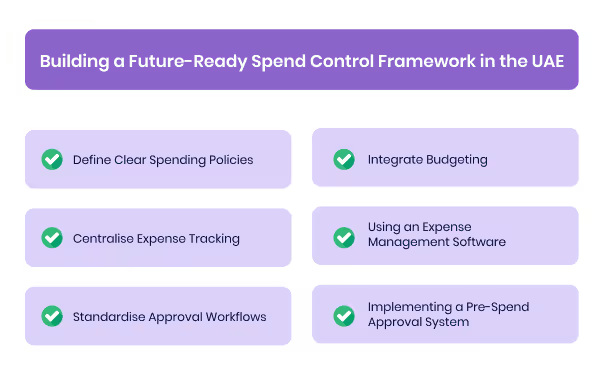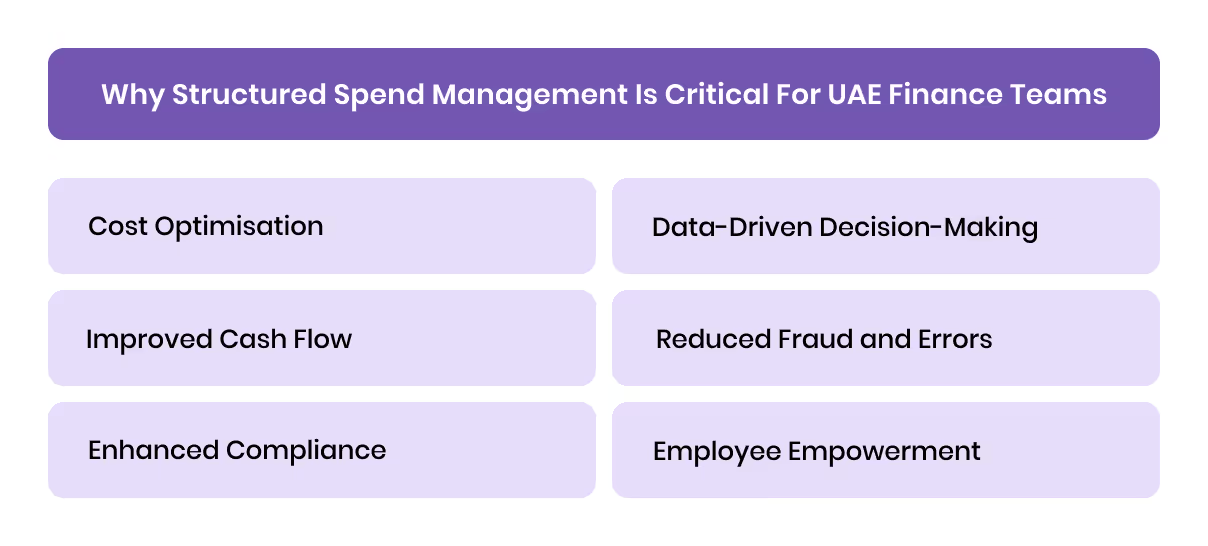Without a solid expenditure management process, companies risk out-of-control costs, delayed approvals, and compliance gaps. As finance teams in the UAE face increasing pressure for accuracy and efficiency, redefining expenditure management has become crucial.
In this article, we’ll explore why a structured process is key to financial control, how to implement it effectively, and how automation simplifies the journey.
Let's cut straight to what your finance team really needs next.
Key Takeaways:
- Proactive Spend Control: A structured expenditure management process gives CFOs real-time visibility and enforces budget discipline.
- Cost Optimisation: Strong frameworks reduce unnecessary expenses and redirect funds to strategic initiatives.
- Compliance & Audit Readiness: Centralised, standardised processes ensure VAT compliance and prepare organisations for audits.
- Automation Benefits: Automated expense capture, approvals, and accounting integration free finance teams to focus on forecasting and strategy.
The Real Value of an Effective Expenditure Management Process

An effective expenditure management process gives you the structure and visibility needed to maintain control over your company's spending. Key advantages include:
- Financial Control: Links every expense to predefined budgets and policies, creating clear boundaries for spend and reducing cash leakage.
- Accountability: Establishes ownership across teams, making it easier to trace transactions, identify anomalies, and prevent policy violations.
- Compliance Assurance: Enforces consistent documentation and VAT standards, reducing audit risk and ensuring readiness for financial reviews.
- Operational Efficiency: Eliminates bottlenecks in approval cycles by creating transparent, rule-based workflows that keep spending aligned with timelines.
- Strategic Visibility: Delivers real-time, consolidated data on spending trends, empowering finance leaders to forecast accurately and reallocate budgets proactively.
When these elements work together, finance teams move from reactive expense reporting to proactive, insight-driven governance, setting the stage for a structured and modern expenditure management framework.
Building a Future-Ready Spend Control Framework in the UAE

A strong expenditure management process depends on consistency, control, and clarity. The goal is to make spending predictable and policy-driven, without slowing down operations or innovation.
1. Define Clear Spending Policies
Every effective expenditure management process begins with clarity. Without defined rules, spending decisions can easily become inconsistent or reactive.
Clear policies create a shared understanding across teams, so spending aligns with business priorities, not individual judgment.
Here’s what a strong policy framework includes:
- Category-specific Guidelines: Clarify what qualifies as business spend for each function. This helps teams act confidently within approved boundaries.
- Approval Thresholds: Set spend limits that balance control with agility, keeping small decisions quick and big ones accountable.
- Documentation Standards: Standardise the receipts, invoices, and proofs required for every transaction. Consistency here makes audits far easier.
- Reimbursement Timelines: Define when claims should be submitted and processed to avoid delays or bottlenecks.
When policies are clear, you reduce confusion, disputes, and last-minute escalations. It becomes easier to spot exceptions early, strengthen financial discipline, and focus on higher-value insights rather than day-to-day corrections.
2. Centralise Expense Tracking
A fragmented view of expenses makes it nearly impossible to manage spend effectively. When data lives across spreadsheets, emails, and individual systems, teams waste valuable time reconciling numbers instead of analysing them.
Centralising expense tracking brings every transaction, from corporate card payments to vendor invoices, into one unified system. It becomes the single source of truth for your finance operations.
What centralisation enables:
- Consistent Data Accuracy: With all expenses logged in one place, discrepancies are caught early, reducing manual corrections.
- Faster Reconciliation: Cross-checking payments, receipts, and approvals becomes faster and more reliable.
- Better Oversight: Finance teams gain a complete view of spend by category, department, or project, allowing quicker course corrections.
- Simplified Audits: Having all records stored centrally ensures that audits are efficient, transparent, and stress-free.
When every dirham spent is tracked in real time and tied to policy, the expenditure management process shifts from reactive monitoring to proactive control. That's the foundation for a finance function that runs on insight, not assumption.
3. Standardise Approval Workflows
Unclear or inconsistent approval paths slow spending decisions and weaken control. According to a survey, 44% of organisations take four to seven days to approve and reimburse expenses, largely due to manual or disjointed workflows.
Standardising approval workflows brings structure and speed to the expenditure management process. It ensures every request, from travel claims to vendor payments, follows a consistent route.
What to focus on:
- Role-Based Approvals: Define spend limits and authorisation levels clearly to prevent bottlenecks.
- Escalation Rules: Pre-set how exceptions are handled so requests don’t get stuck or overlooked.
- Digital Audit Trails: Maintain records of who approved what and when for accountability and easy audits.
- Controlled Flexibility: Allow urgent or recurring spends within limits, without compromising compliance.
With standardised workflows, you cut delays, reduce manual intervention, and strengthen accountability, making your expenditure management process faster and more reliable.
Also Read: Steps to Automate Expense Management and Approvals
4. Integrate Budgeting and Forecasting
When budgeting and forecasting remain manual, finance teams often lag behind in responding to cost overruns or unexpected market shifts. In fact, 63% of finance functions still carry out budgeting and planning in mostly or fully manual ways, creating delays and increasing risk.
Integrating budgeting and forecasting into your expenditure management process ensures every spend decision aligns with financial strategy and future goals.
What to focus on:
- Unified Financial View: Connect real-time expense data with budget dashboards for instant visibility into deviations.
- Scenario Planning: Use historical spend trends to adjust forecasts dynamically — especially valuable during fluctuating costs or seasonal demands.
- Automated Alerts: Set variance thresholds to flag overspending early, before it affects cash flow or targets.
- Cross-Department Collaboration: Encourage department leads to co-own their budgets; this improves accountability and accuracy.
When budgets and forecasts live in the same ecosystem as expense tracking, you gain proactive control, shifting from cost monitoring to strategic cost management.
Also Read: Difference Between Budgeting and Financial Forecasting
5. Using an Expense Management Software
Many organisations still rely on spreadsheets or paper-based systems to manage expenses, a method that slows down reconciliation and increases the risk of inaccuracies.
Switching to expense management software gives finance teams centralised visibility, real-time insights, and accurate records, critical to running an efficient expenditure management process.
What to focus on when selecting and rolling out software:
- Centralised Visibility: Unified dashboards that track all employee and vendor expenses.
- Error Reduction: Automated data matching prevents duplicates and manual entry mistakes.
- Faster Reconciliation: Direct sync with accounting tools shortens close cycles.
- Compliance Readiness: Built-in audit trails and VAT validation simplify financial reporting.
Embedding such software within your expenditure management process transforms it from reactive cost tracking to proactive financial control.
6. Implementing a Pre-Spend Approval System
An effective expenditure management process starts before the expense is made. Pre-spend approvals ensure that every rupee is justified upfront, giving finance leaders tighter control over budgets and compliance.
A survey found that 66% of organisations use manager pre-approved spends to review and authorise expenses before they occur.
By setting clear approval hierarchies and limits, you can prevent discretionary or unplanned costs and maintain alignment between spending decisions and company policy.
What to focus on:
- Clear Approval Flows: Define who approves what type or amount of spend.
- Category-Based Rules: Apply differentiated approvals for travel, vendor, or operational costs.
- Policy Awareness: Integrate expense policies into the same tools employees use to submit requests.
- Timely Alerts: Notify approvers in real time to avoid delays or missed requests.
A well-designed pre-spend approval system turns your expenditure management process into a proactive control mechanism.
With clear budgets, automated approvals, and real-time visibility, CFOs gain control, compliance, and actionable insights across every transaction. Alaan enables UAE finance teams to embed these capabilities seamlessly, connecting corporate cards, approvals, and accounting systems in one ecosystem. This gives leaders the confidence to make informed, compliant spend decisions at scale.
Also Read: Types of Expenses Every Business Should Know
[cta-1]
Why Structured Spend Management Is Critical for UAE Finance Teams

A well-defined expenditure management process does more than maintain order. When every stage of spending is tracked, verified, and approved in real time, finance teams gain control and foresight that directly improve business performance.
Key benefits include:
- Cost Optimisation: By tracking spend against budgets and identifying repetitive or low-value expenses, organisations can redirect funds to more productive initiatives.
- Improved Cash Flow: Predictable approval cycles and accurate forecasting prevent liquidity crunches and help maintain a steady flow of working capital.
- Enhanced Compliance: Consistent documentation and audit-ready data minimise regulatory risk, ensuring adherence to tax and VAT requirements.
- Data-Driven Decision-Making: With structured expense data, finance leaders can analyse trends, benchmark costs, and design smarter spending policies.
- Reduced Fraud and Errors: Built-in approval checks and documentation requirements prevent duplicate claims and reduce the risk of fraudulent submissions.
- Employee Empowerment: Clear spending rules and visibility encourage accountability while reducing friction between teams and finance departments.
A process this strong not only saves money but also reshapes how finance functions operate, shifting from reactive cost control to proactive financial strategy.
Also Read: Top 8 Steps to Master Cash Flow Management for Your Business
Automation x the Expenditure Management Process
Manual expense workflows consume valuable finance hours and are prone to human error. Studies show that finance teams spend up to 40% of their time on manual transaction processing and reconciliation, limiting their ability to focus on strategy.
Where automation adds value:
- Expense Capture: Automatically records every transaction as soon as it occurs, reducing missing or delayed entries.
- Receipt Verification: AI matches receipts with transaction data, flags duplicates, and checks for compliance errors.
- Approval Routing: Dynamic workflows route expenses based on rules and spend limits, removing manual bottlenecks.
- Accounting Sync: Expenses are automatically coded and pushed to accounting systems for instant reconciliation.
- Compliance Tracking: VAT and audit data are validated continuously, cutting month-end stress.
Automation lets finance teams focus on strategy, forecasting, and cost optimisation instead of manual tracking. It’s how modern UAE teams turn data into action.
Also Read: Steps to Automate Your Travel and Expense Management
How Alaan Streamlines the Expenditure Management Process
At Alaan, we've designed our platform to simplify how finance teams manage, monitor, and control every business expense. Each stage of the expenditure management process becomes faster, more transparent, and more compliant.
Here’s how Alaan supports every step:
- Smart Corporate Cards: Instantly issue unlimited corporate cards with predefined spend limits and vendor restrictions. Teams spend securely while finance retains full control over budgets and categories.
- Real-Time Expense Visibility: Every transaction made on an Alaan card is recorded instantly in the platform, giving finance leaders a live view of all expenditures.
- Automated Receipt Management: Employees upload digital receipts directly to the app or via a Chrome extension. Alaan Intelligence reads and verifies them, matching against transaction data to ensure accuracy and VAT compliance.
- Seamless Accounting Integration: Alaan syncs with leading accounting tools such as Xero, QuickBooks, Oracle NetSuite, and Microsoft Dynamics. This ensures transactions are coded, categorised, and reconciled automatically.
- VAT-Ready Compliance: AI checks each expense for valid VAT details, including TRN and tax amount, helping businesses stay compliant and claim eligible VAT with confidence.
- AI-Driven Insights: Alaan Intelligence provides data-backed insights into spend patterns, helping you identify high-cost areas, underutilised budgets, and potential savings opportunities.
Together, these capabilities make the expenditure management process not just simpler but strategically smarter, reducing manual work while improving accuracy and control.
Conclusion
A well-structured expenditure management process is an absolute business advantage. When approvals, budgets, and reconciliations run in sync, organisations gain tighter control over costs, faster reporting, and better compliance.
Automation strengthens this further, reducing manual effort and freeing finance teams to focus on strategy, not spreadsheets.
At Alaan, we help businesses achieve this balance with real-time expense tracking and AI-driven financial insights, all within one connected platform.
Book a Demo and let Alaan help you streamline every step of the expenditure management process.
[cta-4]
FAQs
1. What is the expenditure management process?
The expenditure management process refers to the structured way an organisation plans, approves, tracks, and analyses its business spending. It ensures every dirham spent aligns with budgets, policies, and compliance standards, helping finance teams maintain control and transparency across departments.
2. What are the key stages of an effective expenditure management process?
It typically involves expense planning, approval workflows, recording and categorisation, reconciliation, and reporting. Each stage plays a vital role in ensuring accuracy, accountability, and audit readiness.
3. How often should a company review its expenditure management process?
Most organisations review their expenditure workflows monthly or quarterly to identify leakages, tighten controls, and ensure ongoing policy compliance. Regular reviews support better cost forecasting and smarter decision-making.
4. How does automation improve the expenditure management process?
Automation removes manual bottlenecks, from receipt matching to approval routing, providing real-time visibility and faster reimbursement cycles. This not only saves time but also enhances policy adherence and compliance accuracy.
5. What should finance leaders prioritise when optimising their expenditure management process?
Finance teams should focus on building clear approval hierarchies, ensuring data accuracy, integrating spend systems with accounting tools, and adopting real-time reporting. These priorities help maintain compliance, prevent overspending, and give leaders actionable cost insights.


.avif)







%201.avif)